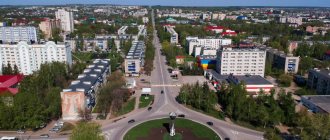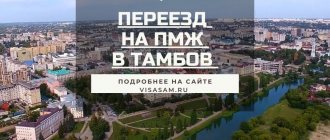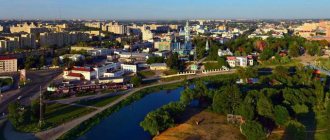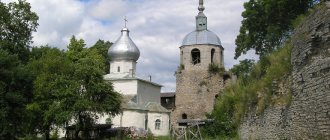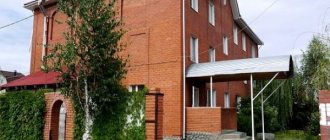History in the 18th century
Now that you know where Bugulma is, it’s worth getting acquainted with the history of the city. So, it is believed that it was founded in 1736. Initially, on the territory of the modern city there was a settlement called Bolshaya Bugulma. Its development began after the founding of the Orenburg fortress. A document has been preserved according to which in 1743, along the New Orenburg Road in Bugulma, arable land, as well as hayfields, forest and other lands, were demarcated for the “non-believers”. A little later, a zemstvo office was established in this settlement, which was responsible for managing foreign and Russian volosts.
At the height of the Pugachev uprising, Bugulma found itself at the center of dramatic events. The headquarters of the commander-in-chief of the regular troops sent to fight the rebels, Chief General Bibikov, was located there.
After the suppression of the uprising, in 1781, Catherine II signed a decree according to which Bugulma received the status of a district town and was assigned to the Ufa governorate.
After 16 years, he was transferred to the Orenburg governorship.
Bugulma Museum of Local Lore
The local history museum has a long and rich history. He has been working in Bugulma since October 1929. During this considerable time, an extensive collection of exhibits has been accumulated, reflecting the entire history of the city since the emergence of the Bugulminskaya Sloboda. The thematic halls of the museum, which are real interior complexes, demonstrate materials from the Pugachev rebellion, the powerful Bugulma fairs of the 19th century, and the periods of the Civil and Great Patriotic Wars. The museum is located in the former family house of landowner Jelacic, built at the end of the 19th century.
In the 19th century
From 1851 to 1920, the city was part of the Samara province.
For most of the 19th century, the city was an important trading center. The fact is that where Bugulma is located, there was a crossroads of several important roads. In particular, caravans heading from Ufa and Orenburg to Kazan passed through it.
150-160 years ago there were three annual fairs there. Of these, Vozdvizhenskaya took place from September 14 to 26 and was considered one of the largest in the Urals in terms of its turnover.
At the fairs held in Bugulma, horses, cattle, raw leather, Bukhara carpets and other goods from Central Asia, tea, leather goods, camel cloth, etc. were sold. Large transactions were concluded at them and a brisk retail trade was conducted.
By 1890, the city had five Orthodox churches, two hospitals and three educational institutions. There was a public bank, a zemstvo library, a post office and a telegraph office. A significant part of the population of Bugulma was employed in 40 factories, mainly brick, pottery, oil mills, etc. In addition, a public garden was laid out in the city, where a brass band played on Sundays and holidays.
At the turn of the 19th-20th centuries, people lived in Bugulma;
- 47% Russians;
- 30% Bashkirs;
- 15% Tatars;
- 8% - Chuvash and Mordovians.
Early 20th century
The development of Bugulma was facilitated by the connection of the Volga-Bugulma railway to the city in 1911. As a result, its role as a major trading center in the region has increased even more. During this period in the Volga region it was difficult to find a person who did not know where Bugulma was located.
Since 1920, the city was the center of the canton of the same name in the Tatar Autonomous Soviet Socialist Republic, and since August 1930 it was given the status of the administrative center of the Bugulminsky district.
After the war
In 1948, the Romashkinskoye oil field was discovered in the vicinity of Bugulma. This event made many people interested in the question of where Bugulma is located.
In 1950, the Tatneft association was founded in the city. In connection with the active development of the Romashkinskoye deposit, in Bugulma in the early 50s the department for exploration and production of “black gold” was located in the entire Tatar Autonomous Soviet Socialist Republic. In addition, the TatNII was created there, as well as the oil transportation center (USZMN).
Thanks to this, within 10 years the population of Bugulma increased 10 times, and for a number of years, until the end of the 60s, it was the 2nd most populous city in the republic, after its capital Kazan.
In 1953, when asked in what region the city of Bugulma is located, where the Tatneft administration is located, they answered: “Bugulma region.” True, this was true only from February 21 to April 30, 1953.
What to see in Bugulma on your own?
Interesting places and main attractions of the city and its surroundings: photos with descriptions, tips on where to go, where to go by car, what to see in one day.
Avenue of Heroes
This is not only a natural, cultural, but also a historical landmark. It was on this alley that busts of the natives of Bugulma were installed in honor of the 30th anniversary of the Great Victory over the Nazis. All the people to whom the Alley of Heroes is dedicated were participants in a military battle and are considered Heroes of the Soviet Union. They performed feats that made them a legend for the entire Bugulma region.
Today the alley looks like a small cozy square. Here you can see many beautiful flower beds, various trees and bushes. There are a large number of comfortable benches on the territory of the park so that everyone can relax. It was between the benches that the busts were installed. Under each of them there is a sign with a small summary of information about the hero.
Bugulma State Russian Drama Theater named after A.V. Batalova
The history of the Bugulma Theater began even before the Great Patriotic War. The building in which the theater is located was built in 1897 as the People's House. It was equipped with a theater hall, which was designed for 350 spectators.
In 1935, the theater received official state status. During the Patriotic War, the director of the theater was N. Olshevskaya, a theater actress, and also the mother of A. Batalov, who became the People's Artist of the USSR. It was in this theater that he began his career as an actor, so in 2008 the theater was named after him.
In Soviet times, the theater troupe delighted audiences with its performances not only in Bugulma, but throughout Russia. In recent years, the theater troupe has constantly delighted city residents with a variety of theatrical performances, which are designed for both children and adults.
Bugulma Museum of Local Lore
One of the oldest museums in the republic was opened in Bugulma on October 1, 1929. The museum has collected many exhibits that tell the history of the development of the city from its inception in 1736 to the present day.
The main exhibition reveals the secrets of the Pugachev uprising, city fairs of the 19th century, as well as the period of great wars and their influence on the lives of city residents.
In the museum you can get acquainted with the animal and plant world of Bugulma, as well as with household items of its inhabitants.
Apartment house of merchant Khakimov
In the central part of Bugulma is the house of the merchant Khakimov. It was built at the beginning of the 19th century and has retained its original appearance to this day. The unique house project was created by the famous architect Ivan Gusarov.
Today the building is the Center of Tatar Culture. It looks like a large light green house, with a dome and a spire on the roof. The façade is decorated with large windows, and inside there are spacious halls with high ceilings.
In Soviet times, a gallery store was opened in the building, and in 1912 the first cinema appeared in it. Despite numerous reconstructions, the building looks exactly the same as in the photographs taken after the construction of the apartment building. This adds to its uniqueness.
Kazan-Bogoroditskaya Church
At the end of the 20th century, in honor of the 1000th anniversary of the baptism of Rus', a church was erected. Its construction lasted five years and was completed in 1993. The picturesque temple is complemented by an asymmetrically attached bell tower, located under the massive dome and rectangular projections on the southern side of the building.
Economy
If you are wondering where Bugulma is in Tatarstan because you are thinking about moving there, you should find out about the economic situation in the city.
Of course, it is in many ways inferior to what it was during the Soviet period. First of all, this is due to the fact that in the 90s many enterprises closed, which led to a deterioration not only in the economic but also in the demographic situation in the city.
Currently operating in Bugulma:
- "Factory of reinforced concrete products";
- garment factory;
- Distillery;
- mechanical named after V. D. Shashina;
- ;
- meat processing plant;
- furniture factory;
- dairy plant;
- TNG-Group LLC;
- electric pump plant;
- brick ;
- Ak Bars Aero;
- and some other industrial enterprises.
The city also has an airport and a railway station.
Sights of Bugulma
Unfortunately, many ancient architectural monuments have not been preserved in the city. Tourists in Bugulma can be recommended to see:
- Exposition of the local history museum. It is housed in one of the oldest buildings in the city, which was built in the 18th century. The local history museum was opened in the 20s of the last century and is one of the oldest in Tatarstan. Of particular interest are documents relating to the Pugachev uprising, as well as a collection of national costumes collected by local ethnographers.
- Russian Drama Theater named after. A. V. Batalova. The theater building was built at the very end of the 19th century. During the Second World War it was led by actress Nina Olshanskaya. She was evacuated to Bugulma with her son, Alexei Batalov. The future famous Russian actor made his debut on the stage of the drama theater at the age of 13. In 2008, it was decided to name the theater after A. Batalov.
- Memorial of Eternal Glory. As described above, during the Second World War, many tank crews found out where Bugulma was located in the Republic of Tataria, since they fought in tanks built at the expense of its residents. After the Victory, a memorial complex was built in the city in memory of those who gave their lives fighting against fascism. It consists of several monuments: the Eternal Flame and a stele in the form of a flag. The names of 5,560 heroes who gave their lives to defend their homeland from the Nazi invaders are carved on it. In 2000, the memorial complex was reconstructed. Its composition was replenished with an armored personnel carrier, the famous T-54 tank and a bomber, on board of which you can read the inscription “Bugulma Collective Farmer”.
- House of the merchant Sh. Khakimov. This building, built in the 19th century, is noteworthy for several reasons. The author of its project is the famous Russian architect Gusarov. At the beginning of the 20th century, the first cinematograph in Bugulma operated there. During the Soviet period, the building turned into a cinema, which was called “Zarya”. Today, in the house of the merchant Sh. Khakimov, the “Center of Tatar Culture” operates.
Bugulma State Russian Drama Theater named after A.V. Batalova
The Drama Theater is located in a building built in 1897, which was erected on the initiative of the Bugulma district committee as a People's House with an auditorium for 350 seats. It is known that already in 1900 there was a theater in the People's House that staged more than twenty performances per season, 12 of which were premieres. The successor to this theater troupe was the amateur group “blueblouses”, which was organized in the People’s House in the 1920s. It grew into a professional state theater. This status was received by the cultural institution in 1935. During the Great Patriotic War, Stanislavsky's student, the Moscow Art Theater and the Red Army Theater actress, and later theater director Nina Olshevskaya, worked in the theater. She came to the evacuation with her children, and for her eldest son, the future famous actor Alexei Batalov (born November 20, 1928), the Bugulma Theater became a launching pad in the profession.
In 2008, on the initiative of the President of Tatarstan Mintimer Shaimiev and in commemoration of the 80th anniversary of Alexei Batalov, the Bugulma State Russian Drama Theater, in which he played his first roles on the big stage as a teenager, was named after him.
Today it is one of the best theaters in small towns in Russia, the winner and laureate of numerous all-Russian and international competitions. The repertoire policy of his troupe is very diverse - from classical productions to light humorous and vaudeville ones. The team holds its mark high and confidently continues the best traditions of the national drama theater. It's definitely worth attending the performance.
Hasek and Bugulma
And finally. Let's go back to where we started. It turns out that during the Civil War, a world-famous Czech writer was appointed commandant of the city. The building of the commandant's office has survived to this day, now turned into a museum of the writer. In addition, a monument to the soldier Schweik was erected on the platform of the Bugulma railway station relatively recently. Next to the brave “warrior” there is a pillar with signs on which are written: “Prague”, “Moscow” and “Ufa”.
Now you know where Bugulma is located in Russia. According to those who have been there, it is a very green city. We can only hope that over time it will develop more and more economically and culturally, and the standard of living of its residents will only improve.
Literary and Memorial Museum of Jaroslav Hasek
From October to December 1918, at the height of the civil war, the famous Czech satirist Jaroslav Hasek served as assistant to the military commandant of the Bugulma district. A twisted fate led him to burning post-revolutionary Russia. During World War I, Hasek zealously evaded conscription, but was forcibly recruited and sent into the active army. At the front, when an opportunity presented itself, he surrendered to Russian troops.
After the formation of the Red Czechoslovak Army on the basis of prisoners of war and its split, he ended up in the part that supported Soviet power. The writer survived the terrible whirlpool of the civil war, and after returning to his homeland, he significantly added new works to the series of humorous stories about the good soldier Švejk, which glorified both himself and all Czech literature. Hasek himself became the prototype of the main character.
The Jaroslav Hasek Literary and Memorial Museum is located in the very building where the military commandant’s office was located. The exhibition includes three exhibition halls and a memorial room. Here are documents, photographs, collections of stories and collected works of the writer in different languages of the world, various souvenirs associated with the extraordinary personality of the satirist writer and his main literary character - the good soldier Schweik.
Source
